SUMMARY
This is AI generated summarization, which may have errors. For context, always refer to the full article.
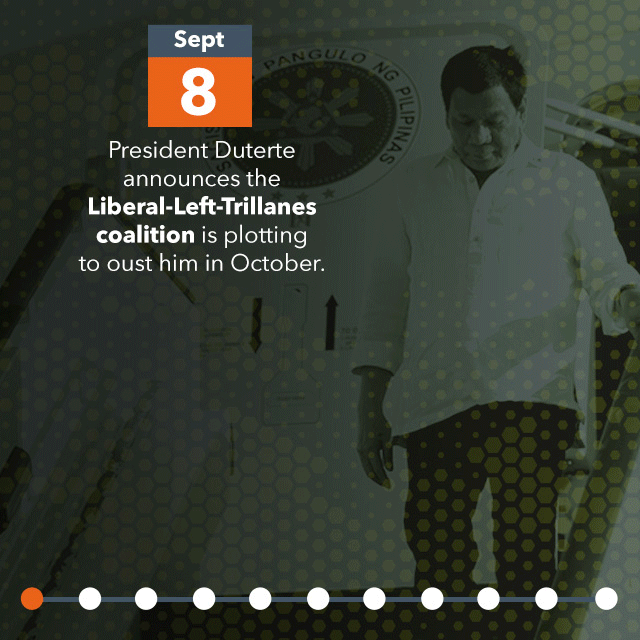
MANILA, Philippines – It’s a plot like no other – with dizzying twists and turns, a mixed bag of characters, and fast-changing episodes as told by various storytellers.
For all of that, it stuck to one theme: a broad coalition from left to center to right is plotting to bring down President Rodrigo Duterte.
No less than Duterte exposed this supposed plot in September, followed by the military and the police through bits and pieces of information. The plot exempted no one from among the sectors and personalities known to oppose Duterte, clustering communist rebels with the erstwhile ruling party, the Liberal Party, and ex-mutineers under the Magdalo Group, among others.
It came to a point that even soldiers – usually exempt from Duterte’s tirades – were tagged as being part of the plot.
But October came and went and the President not only remains firmly in power, his destabilizers never even came close to mounting anything.
Despite this, the military insisted that the plot has not been abandoned but only moved to another target date.
The narrative subsequently took on many forms – such as a matrix containing the identities of plotters that included Vice President Leni Robredo, a dead bishop, and – hold your breath – Jollibee.
We trace how Red October has turned from what the President first revealed up to his son Paolo’s version of it.
September 8: They want to oust me!
In Davao, Duterte announces what he calls an emerging ouster plot planned by a coalition allegedly comprised of the Liberal Party, his fierce critic Senator Antonio Trillanes IV, and the Communist Party of the Philippines.
“Tatlong ‘yan, bantayan ninyo. Iyang Yellow, Liberals, Trillanes, pati ang politburo (Those three, watch out for them. The yellow, librels, Trillanes, and the [communist] politburo),” Duterte said, just after coming back from a visit to Israel and Jordan.
September 9: ‘Paranoia’
The identified groups deny Duterte’s accusation. Trillanes describes the President as a victim of his own “paranoia,” saying it wasn’t the first time he’d spoken about a planned destabilization move against him.
The Liberal Party, through its chairperson Vice President Robredo, denies any connection with the Communist Party of the Philippines (CPP). “[W]ala kaming koneksyon sa Communist Party of the Philippines, ni nag-usap, wala man lang kahit anong klaseng pag-uusap (We don’t have any connection with the CPP, not even any conversation, not any kind of conversation),” says Robredo during her regular radio guesting for the Radio Mindanao Network.
The CPP, meanwhile, issues a statement seen to bolster Duterte’s thinking – without confirming anything. “Mas malaki na ang following dahil sunod sila (LP, CPP, Trillanes) sa kagustuhan ng sambayanang pilipino na patalsikin si Duterte…Pinaka-malawak na concern ng tao ‘yung pagbulusok ng ekonomiya lalo na sa anyo ng pagtaas palipad ng mga presyo,” says the CPP’s exiled founding chairperson, Jose Maria Sison, in an ABS-CBN News Channel (ANC) interview.
(They have a larger following because they follow the will of the Filipino people, that Duterte should be ousted…The biggest concern for the people is the downturn of the economy, especially the soaring prices.)
At the time of the statement, the peace talks between the government and the guerrillas had been suspended. Bringing down governments is at the core of the rebels’ strategy and tactics in the more than 40 years that they have been waging Asia’s longest communist insurgency.
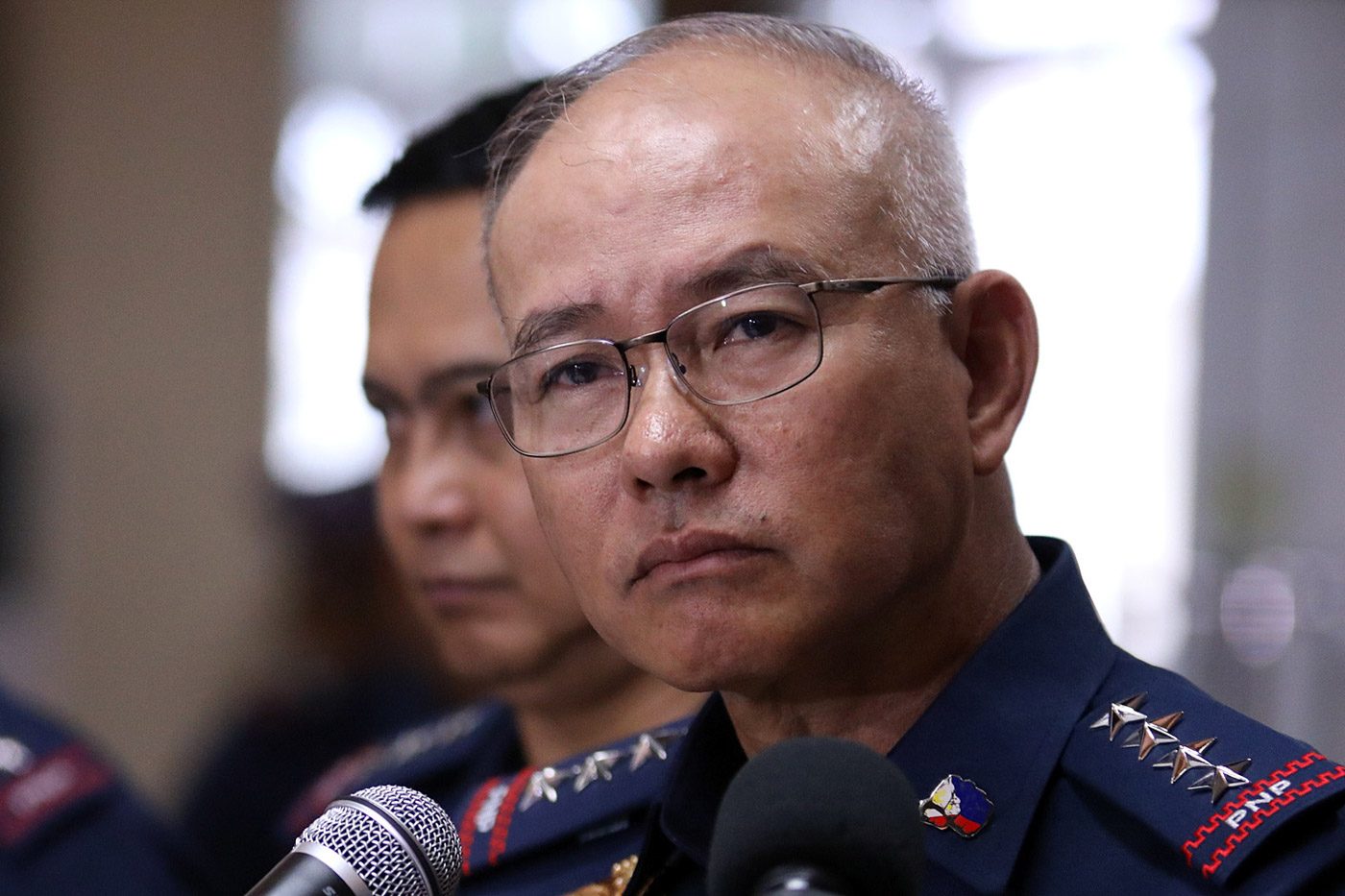
September 10: Not verified
After the conspiracy scare simmered, reporters ask police and military officers for more details of the supposed plot.
Police chief Oscar Albayalde and Defense Secretary Delfin Lorenzana say the claims have yet to be verified.
Lorenzana, a retired two-star military general, says he only knew of a plot hatched by the CPP-NPA, but not of any opposition party or group—or soldiers for that matter.
September 11: What alliance?
Following a TV interview, Sison tells the Philippine Daily Inquirer that they have no tie-up with the Liberal Party or Senator Trillanes. He adds the CPP is open to cooperation with other groups, but “as far as I know, there are yet no talks between the CPP and Trillanes group or the Liberal Party.”
September 12: June prediction
Sison says Duterte will likely be ousted by June 2019, citing rising prices and weakening support as key triggers.
September 19: Martial Law anniversary as D-Day
Police spokesman Chief Superintendent Benigno Durana adds a new twist to the story: the so-called “Oplan Aklasan.”
“The activity is reportedly to launch a massive rally and violent demonstrations in critical strategic areas in Metro Manila in order to encourage the public to lose support to the present government,” Durana says in a press briefing.
The timetable is September 21, the anniversary of the declaration of Martial Law by late dictator Ferdinand Marcos, which is always commemorated with protests.

September 20: AFP says it’s for real
Breaking its silence, the Armed Forces of the Philippines (AFP) confirms the President’s announcement in an interview with ANC’s Tina Monzon-Palma.
AFP Assistant Deputy Chief of Staff for Operations Brigadier General Antonio Parlade identifies the supposed lead group in the broad coalition: the Movement Against Tyranny, a leftist group formed in August 2017 in the wake of the sensational killing of 17-year-old Kian delos Santos by policemen.
Parlade says the opposition coalition group Tindig Pilipinas – even the Coalition for Justice, which backed former chief justice Maria Lourdes Sereno – were in cahoots with the Movement Against Tyranny for the ouster plot.
“It’s a broad coalition being orchestrated by the communist party…with that broad coalition they have included CFJ (Coalition for Justice) with Supreme Court justice Sereno…and there’s this Tindig Pilipinas, incidentally the Tindig Pilipinas includes the Liberal Party,” Parlade says.
“These 3 are being orchestrated by the Communist Party secretariat,” Parlade adds.
More details emerge in the interview: that the initial target date is September 21, matching the PNP’s earlier announcement. There would be a nationwide “Aklasan” where workers from different companies, including popular restaurant chain Jollibee, plan to stage strikes and paralyze the manufacturing industry before taking to the streets in protest.
If this didn’t pan out in September, the plotters will move their timeline to October. Thus, Red October was born – as confirmed by the AFP.
“If they cannot generate the critical mass they want to generate this 21 September, they will continue their plans until next month. They also have this October, Red October,” Parlade tells Palma after the veteran journalist asked how the ouster plot would play out.
September 21: Rallies – nothing more
Pronounced by authorities as a significant day in the “rolling plot,” the September 21 protests turn out to be nothing extraordinary. Workers did not stage walkouts, and the number of warm bodies on the streets was not enough to scare anyone.
Metro Manila police chief Director Guillermo Eleazar describes the main protest areas as “very peaceful.”
September 24: Red-baiting
The Movement Against Tyranny speaks up, calling the alleged plot “outlandish” and a case of “red-baiting.”
Malacañang clears Vice President Robredo of involvement in the plan. Presidential Spokesman Harry Roque says Robredo was not mentioned by the military in any of their briefings.
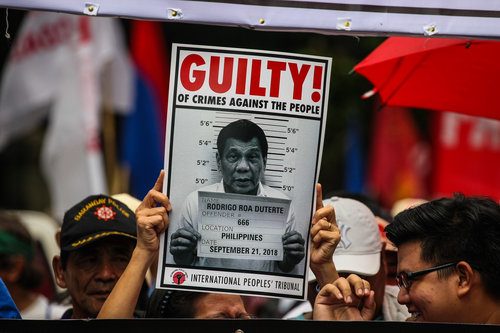
September 25: Tagging soldiers
Duterte adds more characters to the story, saying that even non-Magdalo soldiers were part of the plan to oust him.
“What pains me here is that the Liberals, also those in the military, they reached out to the rebel soldiers, and then there – the Yellows, the soldiers whose brains you cannot understand as to where their loyalty lies, as well as the Liberals,” Duterte said.
The CPP claims there would be organic protests for an ouster because of the economic problems in the Duterte administration. But it dismisses the plot as an “invention” and work of “fiction” of the military.
September 26: ‘Initial recruitment’
Former military chief and current Interior and Local Government Secretary Eduardo Año echoes Duterte’s claim about soldiers joining Red October.
He tells reporters that the AFP had monitored “initial recruitment” within the military to the ouster plot, which was supposedly the turning point for them to expose the alleged conspiracy.
September 27: AFP backtracks
In another television interview, this time with CNN Philippines’ Pinky Webb, Parlade issues a clarification: That the opposition groups Tindig Pilipinas, CFJ, and Magdalo may not be aware that they were being used by the CPP, and that they might not be really after Duterte’s ouster after all.
“I think they (opposition) are not running to that objective (ouster), I really don’t know,” Parlade now says. “But what I am saying is the Communist Party is trying to gather as much support in order to topple the President,” he adds.
Webb asks Parlade whether Tindig Pilipinas, which had earlier denied involvement in any ouster, was aware of them supposedly being used by communist insurgents. Parlade replies: “I don’t know with them, that’s what they’re saying.”
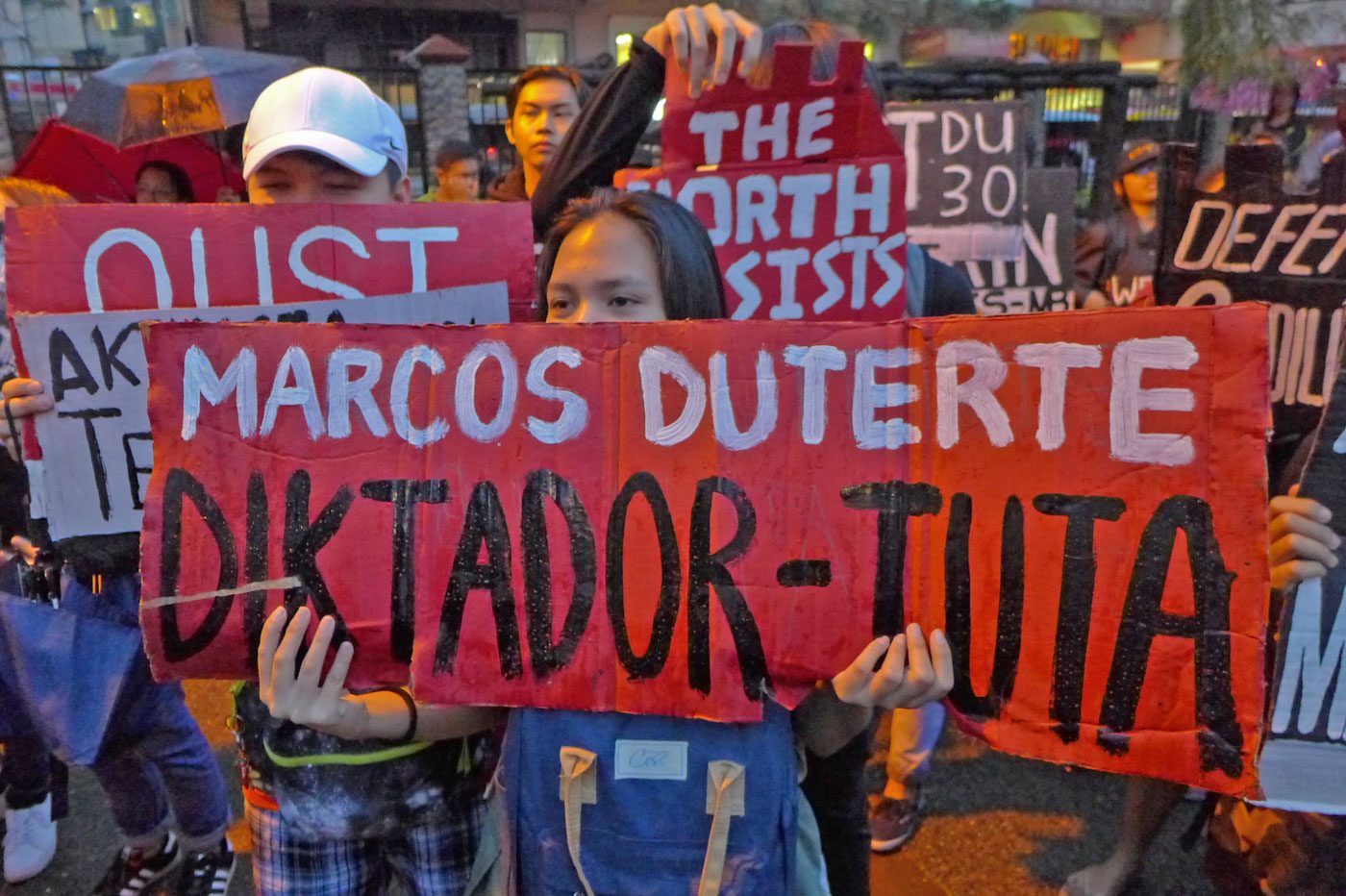
October 1: Foiled plan
Parlade announces that they anticipate communist attacks to peak in mid-October – again as part of the alleged plot.
The general offers yet another twist: that members of opposition groups pulled back from the supposed plot, claiming that Duterte’s announcement had already foiled the plan.
October 2: LP not involved?
Changing tune under oath at the Senate, AFP chief General Galvez clears the Liberal Party and Magdalo in the supposed Red October plot. In the same hearing, Galvez says students from 10 universities were recruited for the ouster plot.
Malacañang insists again on the involvement of the Liberal Party.
October 3: Zero in on schools
The AFP, through Parlade, releases a list of universities where CPP-NPA allegedly recruits students for the supposed ouster plot.
On the list are prominent universities such as the University of the Philippines, long a bastion of student activism, and the Jesuit-run Ateneo de Manila University.
October 4: Universities cry foul
Schools fire back at the AFP for “red-tagging” their students.
“For an institution that’s endowed with much discretionary funds, this is the intelligence report that we get – a poorly-written research that will not even pass for a basic college essay,” says All UP Academic Employees Union (AUPAEU) president Carl Ramona.
On the same day, an admission from the military: That the list of schools released the day before has not been fully verified.
“The list of Metro Manila schools that have been possibly used as venues for arousing, organizing, and mobilizing of students by the NPA has been released. Some of the schools included in the list as such, however, are subject of continuing validation,” the AFP says in a statement to reporters.
October 7: Transpo strikes too?
The Department of Transportation chimes in, linking transportation strikes to the ouster plot.
But transport groups were only planning to repeat what they had done the previous year: to protest soaring fuel prices and the DOTr-led jeepney modernization program.
October 12: Not happening
Almost halfway through October, Defense Secretary Lorenzana says the Red October plan was not pushing through.
Lorenzana claims that the supposed coalition fell apart, along with the plot, after the President and the military spilled the beans on them.
October 15: New date for plot
The military declares the conspiracy lives on! They have a new date for it: in December, when the CPP-NPA celebrates its 50th founding anniversary.
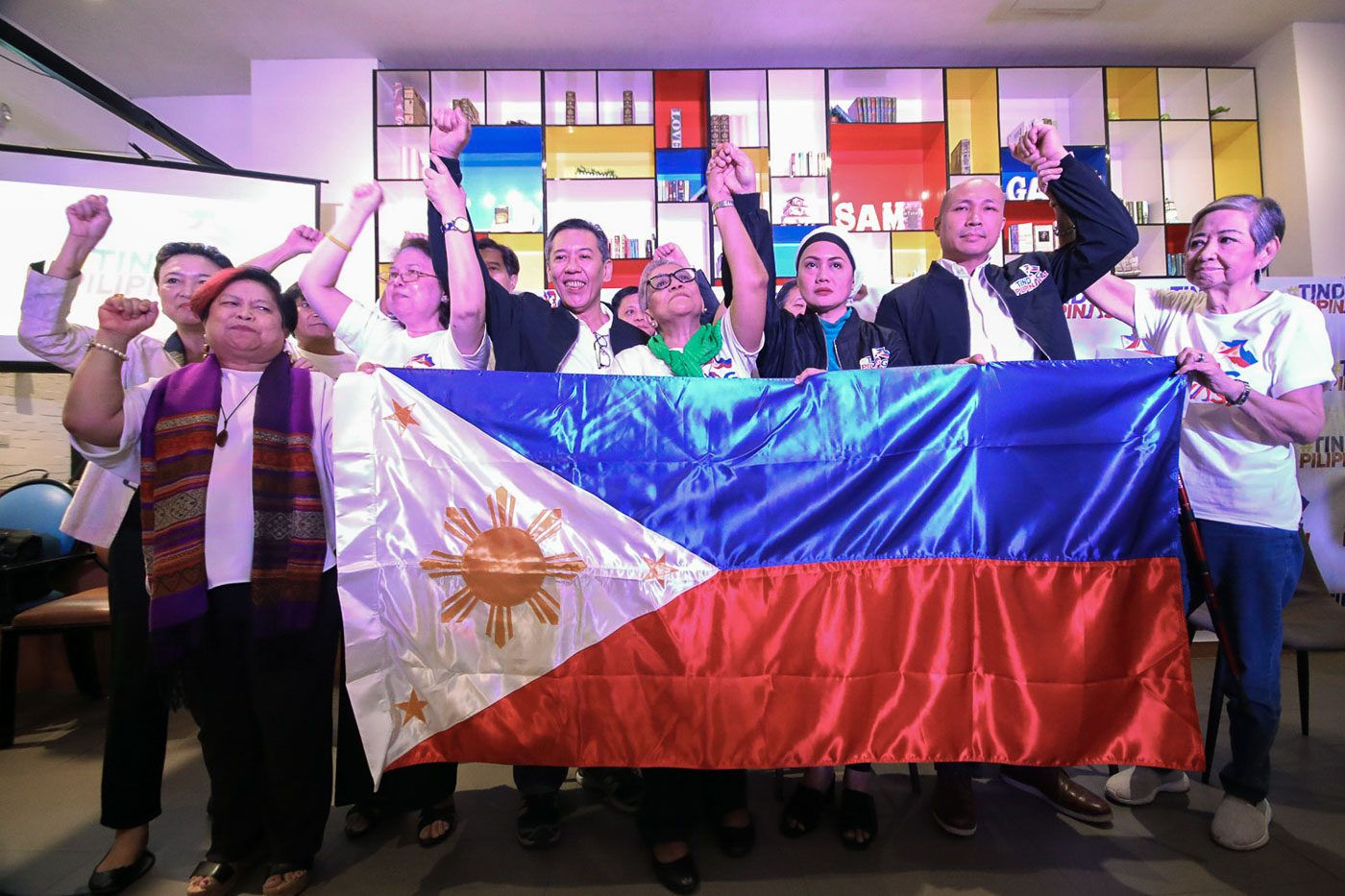
October 17: Sison’s denial, again
Joma Sison denies any December ouster moves against Duterte.
October 18: Fearless forecast
Sison admits the CPP-NPA, on their own, could not overthrow Duterte through force. He foresees mass rebellion triggered by rising prices of basic goods.
His fearless forecast comes after the release of the September Pulse Asia survey that showed Duterte hit his lowest public opinion ratings yet. But Sison does not acknowledge what the survey stressed: that the President was still trusted by the majority of Filipinos.
October 21: Sagay massacre
Nine sugar farmers are gunned down in an ambush in a Sagay City, Negros Occidental hacienda.
October 24: Bigger plan
The AFP says the Sagay massacre was part of the plot to oust Duterte, a claim echoed by the police. According to top police and military officials, the killing may have been used to fuel anger against the government.
“There is a larger intention of really putting the President and the government in a bad light,” AFP chief Galvez says.
October 27: NPA’s fault
Duterte blames communist rebels for the Sagay massacre – without citing evidence.
November 10: Talks again?
Despite the destabilization scare, Duterte again expresses openness to meet with top leaders of the National Democratic Front, the communist rebels’ political organization.
November 29: Foiled, again
AFP spokesman Brigadier General Edgard Arevalo repeats that the ouster plot has already been foiled.
“It did not happen, because we were able to prevent it from happening because of the announcements made,” Arevalo says in a briefing in Camp Aguinaldo.
December 7: Paolo’s (deleted) version
Presidential son and former Davao City Vice Mayor Paolo Duterte hops in on the bandwagon, posting an Excel sheet containing the names of people and groups wanting to bring down his father.
The supposed “Anti Administration Group” plotting an “Oust Duterte Movement” included Vice President Robredo, Catholic bishops, business establishments like popular fast-food chain Jollibee, and media personalities such as Rappler CEO Maria Ressa – a claim dismissed and laughed off by those named. (READ: What do Leni Robredo and Jollibee have in common?)
He deletes it after a day, already too late to evade screenshots.
December 11: It’s fake
Without mincing words, Lorenzana tags Paolo Duterte’s post as “fake news.”
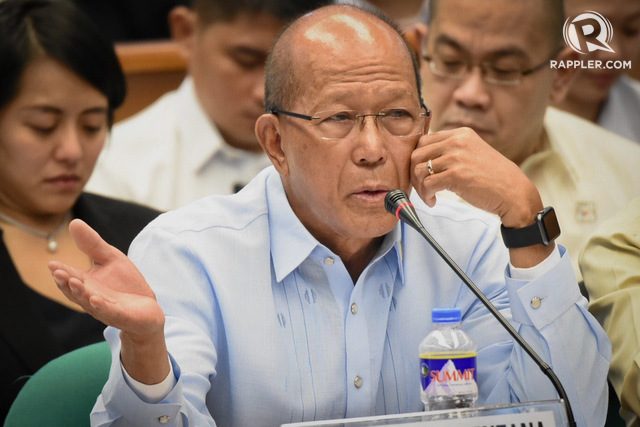
Proof still confidential
The military and the police have been steadfast in their position that the conspiracy is real. They have damning documents, they said, but have refused to divulge them to the public.
These documents, Parlade said in multiple interviews, came from laptops seized from a joint police and military operation in General Santos City sometime in July 2018. Parlade said they contained “terabytes of information” on the ouster plot.
According to a police source privy to the operation, Parlade was referring to the arrest of 13 Cagayan de Oro-based social development workers on July 4, 2018 by the police Criminal Investigation and Detection Group and the Army-led Joint Task Force General Santos City.
Cops and soldiers accused 2 of the 13 as part of the NPA, while the rest have been identified as local leaders of cause-oriented groups like Kalumbay, Kilusang Magbubukid ng Pilipinas, Kabataan partylist, League of Filipino Students and Karapatan.
Their arrest was immediately slammed by Allan Khen Apus, the convenor of Movement Against Tyranny in Northern Mindanao, saying, “These individuals were arrested with no weapon on them but their laptops, pens, and papers.”
According to Parlade, the documents are still being studied by the military and the police.
And so we wait with bated breath.
There’s always, after all, a Red October – 2019 version. – Rappler.com
Add a comment
How does this make you feel?
There are no comments yet. Add your comment to start the conversation.